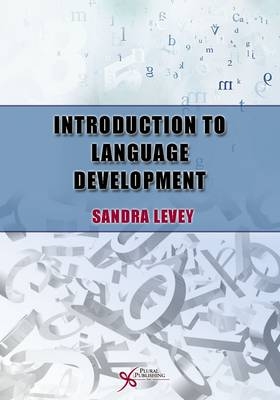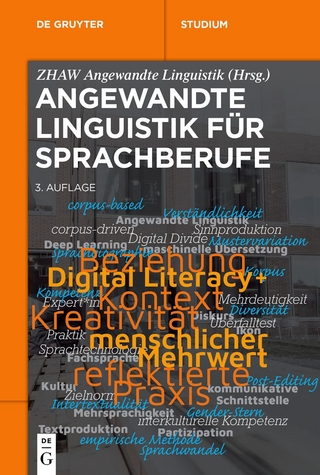
Introduction to Language Development
Plural Publishing Inc (Verlag)
978-1-59756-489-2 (ISBN)
- Titel ist leider vergriffen;
keine Neuauflage - Artikel merken
Introduction to Language Development provides an up-to-date yet comprehensible introduction to the complexity of language development. The textbook is designed for use in language acquisition courses in undergraduate and graduate-level courses in speech-language pathology programs. The primary components of language development (morphology, phonology, semantics, syntax, pragmatics, literacy development, and multicultural and multilinguistic differences) are presented in an uncomplicated manner, along with examples that illustrate children's speech and language behaviors. Key features: Each chapter begins with an illustrative vignette and learning objectives to support students' understanding of the main points. Within the chapters, tables and figures provide examples and features that elaborate and clarify the information presented. Study questions appear at the end of each chapter to assure students grasp and retain the information presented in the text and classroom lectures. A comprehensive glossary of key words in each chapter helps students locate the definitions of key terms.An Introduction to Language Development Workbook is also available to help reinforce student comprehension of the material in the textbook.
Sandra Levey is a faculty member at the City University of New York, Lehman College. She received her Ph.D. in Speech-Language-Hearing Sciences at the Graduate Center of the City University of New York and an M.A. in Linguistics from Stanford University, with a minor in African Studies. Dr. Levey has been designated by ASHA as a Board Recognized Specialist in Child Language. She has received research grants for study at Bayero University in Kano, Nigeria, and has served as a consultant in Bratislava, Slovakia, for a study of Slovakian children's morpheme acquisition and as a guest lecturer for speech-language pathologists and linguists from Slovakia and the Czech Republic. In 1985, she was the Conference Coordinator of the Stanford Child Language Research Forum for the Stanford University Department of Linguistics. Dr. Levey's research and publications have focused on bilingualism and cultural differences, and she has presented her research efforts at national and international conferences. She is the editor and chapter author of Language Development: Understanding Diversity in the Classroom, a textbook designed to help pre-teachers understand children's language development and the language diversity found in classrooms.
Preface Acknowledgments Contributors Chapter 1. An Introduction to Language Acquisition Sandra Levey Chapter Objectives Communication, Speech, and Language Form Content Use Cognition A Survey of Communication Disorders Communication Disorders and Speech and Language Differences Strategies to Identify Children with Communication Disorders Pragmatics Summary Key Words Study Questions References Chapter 2. An Introduction to Theories of Language Development Sandra Levey Chapter Objectives An Introduction to the Theories of Language Acquisition and Development The Nurture Theory of Language Development The Nature Theory of Language Development The Nature and Nurture Theories of Language Development Theories That Combine Innate Skills and the environment in Language Development Summary Key Words Study Questions References Chapter 3. Speech Production Stephen A. Cavallo and Sandra Levey Chapter Objectives Speech Production: A Complex, Motor Act Phonation Phonemes english Vowels Consonants Voicing Summary Key Words Study Questions References Chapter 4. The Brain and Speech and Language Development Sandra Levey and Stephen A. Cavallo Chapter Objectives Skills Associated With the Brain The human Nervous System The Neuron The Cranial Nerves Language and the Brain Neurological Disorders and Speech and Language Functions Summary Key Words Study Questions References Chapter 5. Infant and Toddler Language Development Sandra Levey An Overview of Infant and Toddler Language Development Chapter Objectives Infant Perception and Production Parent and Child Interaction Early Language Development Joint Attention and Joint Action Cognitive Development Play Phonological Development Morphological Development Syntactic Development The Components of the Basic Sentence Form The Development of Negative, Interrogative, and Imperative Sentence Forms Semantic Development Pragmatic Development Narrative Development Summary Key Words Study Questions References Chapter 6. Preschool-Age Children's Language Development Sandra Levey An Overview of Preschool-Age Children's Language Development Chapter Objectives Cognitive Development Play and Language Morphological Development Syntactic Development The Interaction Between Syntax and Semantics An explanation of Syntactic Development Syntactic Differences Preschool Children's Phonological Processes Semantic Development Pragmatic Development Emergent Literacy Summary Key Words Study Questions References Chapter 7. Language Development in Middle and Late Childhood and Adolescence Cheryl Smith Gabig Chapter Objectives Sources of Language Development in School-Age Children and Adolescents The Five Sources That Play a Role in Language Development Developmental Changes in Language Form: Complex Syntax and Morphological Knowledge and Use Developmental Changes in Language Content: Vocabulary and Figurative Language Pragmatic Language Development: Narrative and expository Language Summary of Language Development in Middle and Late Childhood and Adolescents Key Words Study Questions References Chapter 8. The Development of Literacy Skills Sylvia F. Diehl Chapter Objectives The Development of Literacy Emergent Literacy Literacy Development in the Preschool Years Supporting Literacy Development in the Preschool Years Literacy Development in the elementary School Years Supporting Literacy Development in the elementary School Years Literacy Development in Adolescence Supporting Adolescent Literacy Development Summary Key Words Study Questions References Chapter 9. Factors Associated with Delivering Speech and Language Services to Bilinguals Brian A. Goldstein Chapter Objectives What's in a Name? Complexity in Defining Bilingual Bilingual Speech and Language Acquisition Language Development in Second-Language Acquisition Transfer and Code-Mixing Language Loss/Language Disorder Assessment of Speech and Language Disorders in Bilingual Children Intervention Myth or Fact? Revisited Summary Key Words Study Questions References Chapter 10. The effect of hearing Loss on Language Brian J. Fligor An Overview of the Role of hearing Development Chapter Objectives An explanation of hearing Abilities Sound Intensity Defined The Impact of a hearing Loss on Language Development The Permanency of hearing Loss Signs of a hearing Loss Age of Onset of hearing Loss Type, Degree, and Configuration of hearing Loss Caveats to the Type of hearing Loss Denoted by the Audiogram Hearing Assessment Central Auditory Processing Disorders (CAPD) Physiologic Measures of Auditory Function Intervention Devices Used for hearing habilitation: FM Systems, Hearing Aids, and Cochlear Implants Summary Key Words Study Questions References Glossary Index
| Zusatzinfo | b/w illustrations |
|---|---|
| Verlagsort | San Diego |
| Sprache | englisch |
| Maße | 178 x 254 mm |
| Gewicht | 635 g |
| Themenwelt | Geisteswissenschaften ► Sprach- / Literaturwissenschaft ► Sprachwissenschaft |
| Medizin / Pharmazie ► Gesundheitsfachberufe ► Logopädie | |
| ISBN-10 | 1-59756-489-3 / 1597564893 |
| ISBN-13 | 978-1-59756-489-2 / 9781597564892 |
| Zustand | Neuware |
| Haben Sie eine Frage zum Produkt? |
aus dem Bereich


